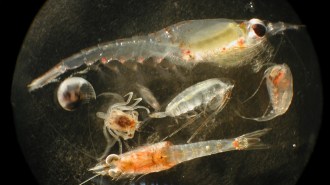Widespread extinctions in the world’s oceans millions of years ago may have been triggered by massive underwater volcanic eruptions that created much of the Caribbean seafloor.
About 93.5 million years ago, many types of deep-sea creatures, including large clams and various microorganisms that lived on the seafloor, died out. At the same time, thick layers of organic-rich marine sediments accumulated at several sites worldwide, says Steven C. Turgeon, a geochemist at the University of Alberta in Edmonton.
The layers, such as a 1.2-meter-thick black shale layer off the northeastern coast of South America that contains as much as 23 percent organic matter, suggest that the waters bathing ocean floors across the globe at the time contained little if any dissolved oxygen, he notes.
Similar events, which scientists have dubbed oceanic anoxic events, pepper the geologic record, and their causes have long remained unexplained. Now geochemical clues in the sediments link the low-oxygen episode of 93.5 million years ago, called OAE2, to the beginning of an extended period of underwater volcanism in what is now the Caribbean, Turgeon and UA colleague Robert A. Creaser propose in the July 17 Nature.
Specifically, Turgeon and Creaser looked at the ratio of osmium isotopes in 93.5-million-year-old rocks from a seafloor site off South America, as well as a site in Italy where marine rocks of the same age are preserved.
Whereas deep-earth magma and extraterrestrial sources of osmium are rich in osmium-188, the osmium that slowly erodes from continental rocks is rich in osmium-187. Unlike many of the other elements dissolved in seawater in small quantities, osmium has a short lifetime in the ocean, remaining dissolved only for about 10,000 years Turgeon says. Therefore, any short-term changes in osmium input to the oceans would be readily chronicled in marine sediments, he notes.
In the rock samples they studied, the researchers found that osmium-isotope ratios were relatively stable before the 500,000-year-long OAE2 episode began. Then, the concentration of osmium locked in rocks deposited during OAE2 — and particularly, the proportion of osmium-188 found there — skyrocketed, says Turgeon. Data suggest that more than 97 percent of the osmium in those organic-rich sediments came from either deep-earth magma or from an extraterrestrial impact.
Because no evidence for an impact from that era has yet been found, Turgeon and Creaser pin the blame on a massive surge of volcanic activity. The largest region of ocean crust solidified from the resulting magma about 93 million years ago now lies beneath the Caribbean, the researchers note.
The immense amount of highly reactive minerals injected into the ocean by the undersea eruptions would have robbed the seas of oxygen, the researchers speculate. Furthermore, they say, those minerals may have served as nutrients for the phytoplankton at the ocean’s surface — organisms that, when they died, fell to the bottom and decomposed, thereby stripping even more oxygen from the depths.
The new findings indicate that a large amount of volcanic activity triggered OAE2, says Timothy J. Bralower, a marine geologist at PennsylvaniaStateUniversity in University Park. “That’s by far the biggest find of this paper,” he notes. Other factors, such as sluggish ocean circulation, might have played a role as well. The world then was several degrees Celsius warmer than it is today, and the temperature difference between the poles and the tropics wasn’t as large. So, he explains, the temperature-driven circulation that oxygenates today’s oceans wouldn’t have been as efficient. Whereas the waters in today’s oceans circulate once every 1,500 years, the chemical composition of OAE2 sediments hint that the oceans of that time circulated only once every 23,000 years.




